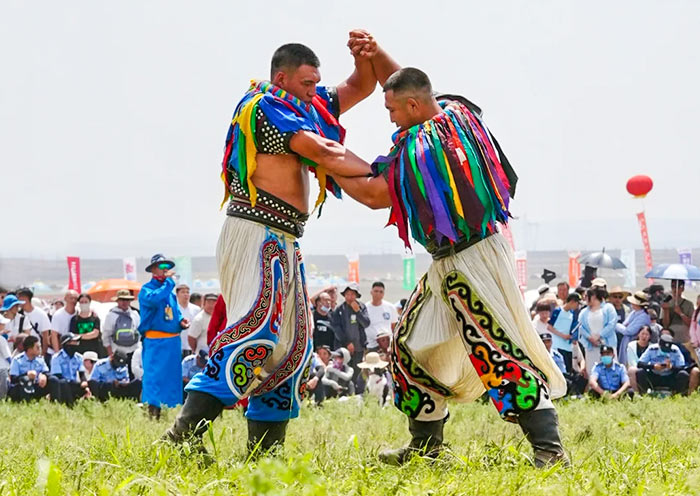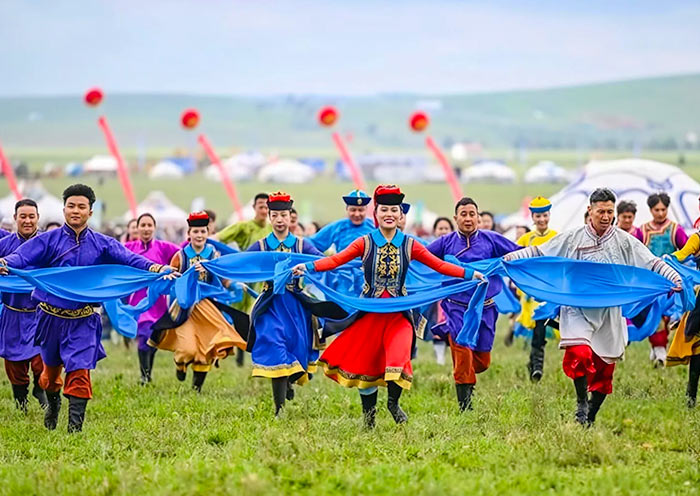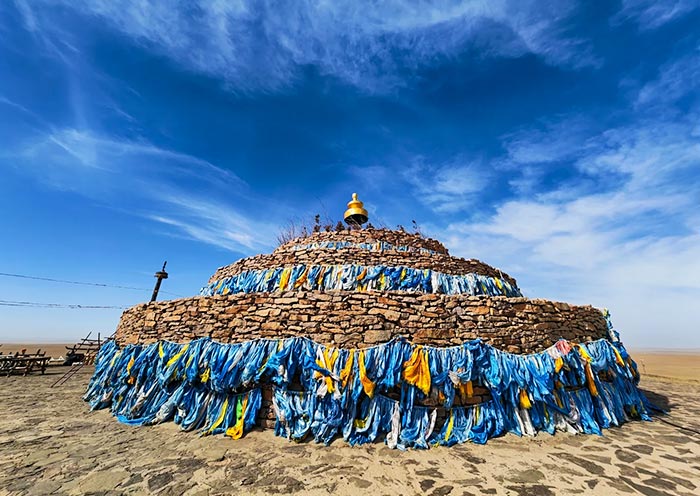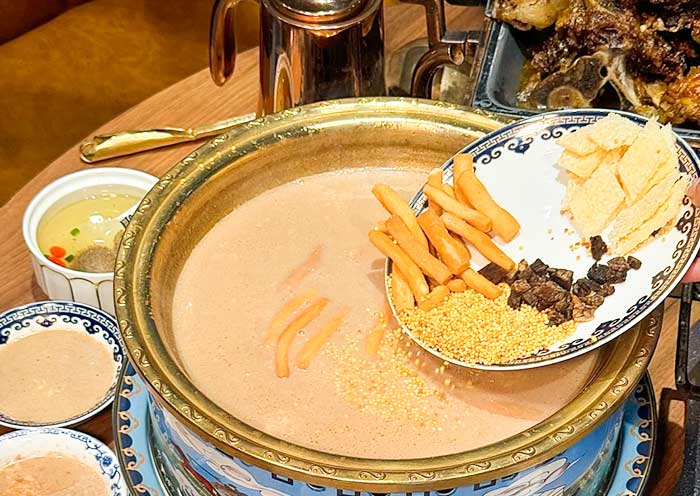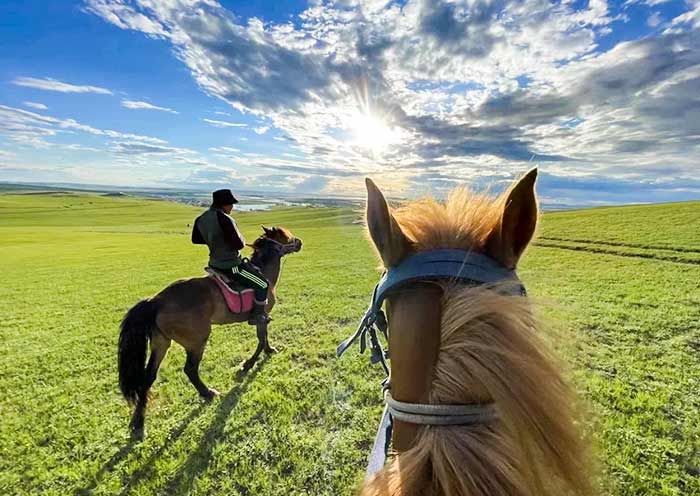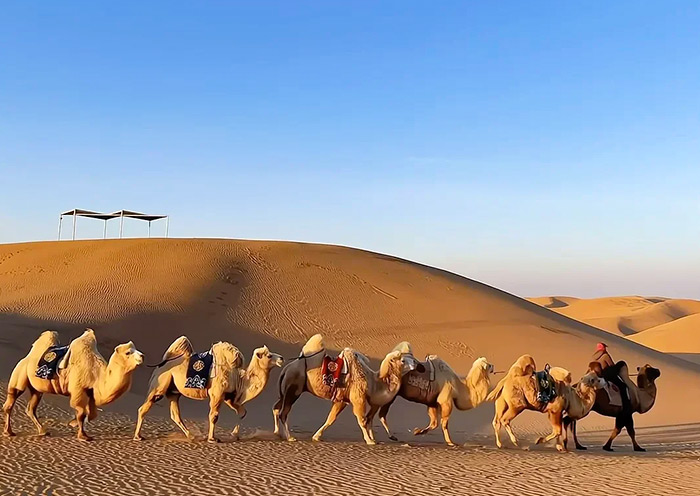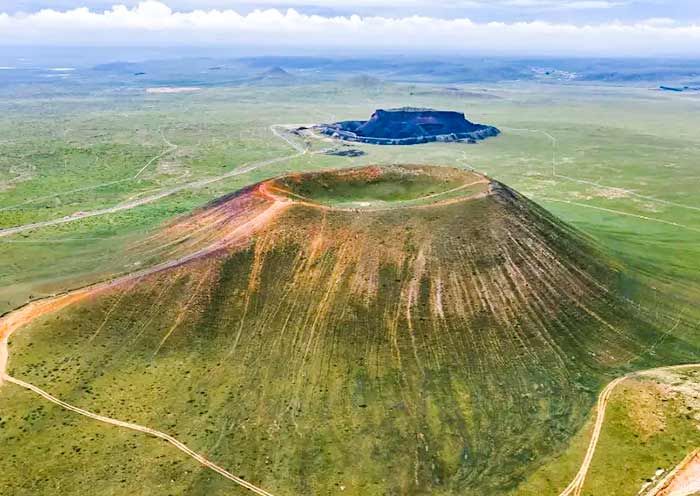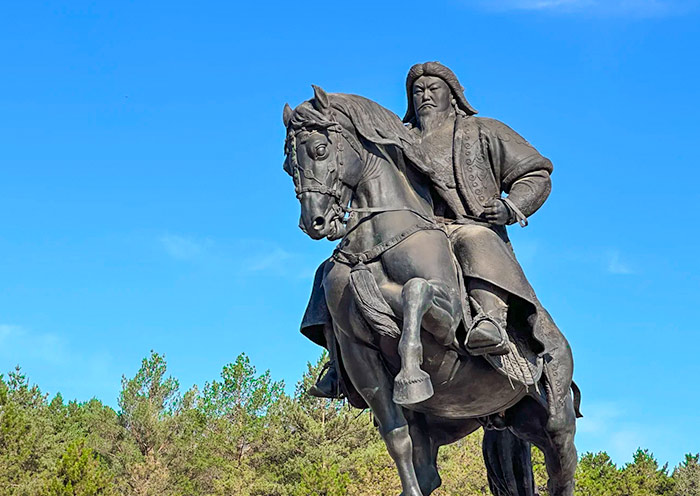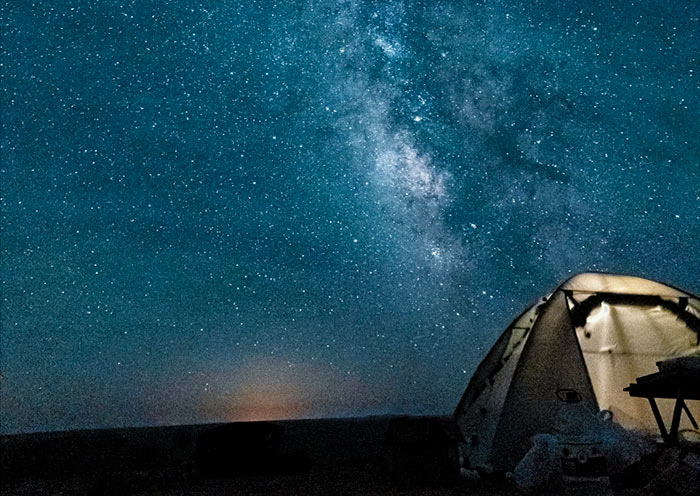Our Naadam Festival tour was unforgettable! Rita is supper patient to check the dates of Naadam for us. Our guide, Suzy, brought the vibrant traditions to life with insightful stories and ensured we captured every thrilling moment—from horse racing to wrestling. Our driver, Sam, navigated vast landscapes effortlessly, making the journey as memorable as the festival. A perfect blend of culture and adventure!
6 Days Naadam Festival Tour 2025: Attend the Grandest Festival in Inner Mongolia
- Highlights
- Itinerary
- Price
- Trip Notes
- Accommodation
- Photos
- Reviews
Best Summer Vacation to Inner Mongolia in July for “Festival of the Grasslands”
What is Naadam Festival? Why is the Naadam Festival celebrated? Join our Mongolia Naadam Tour to discover! Naadam is the most important Mongolia Festival, marking the grandest celebration in Mongolian life. As one of China's beloved summer destinations, visiting Inner Mongolia during Naadam is an excellent choice. As a feast for the grassland nomads, Naadam is also a paradise for photography enthusiasts.
Why take our 6 Days Naadam Festival Tour?
1.Join the Naadam Festival at Xilamuren Grassland: Witness the vibrant celebration of Naadam featuring the finest Mongolian dance, music, and traditions. Experience Mongolia's Three Manly Games (horse racing, wrestling, archery) along with other sports and activities.
2.Experience the Vast Landscapes of Inner Mongolia: From Xilamuren Grassland to Kubuqi Desert, you can freely ride a horse or camel across the expansive terrain. Delight in the Starry Night at a Mongolian Yurt or a Desert Camp/Hotel. Enjoy a variety of Grassland/Desert activities for endless fun.
3.Discover Mongolian Culture and its Renowned Historical Figures: Ideal tour for enthusiasts of Mongolian history, culture, and traditions. Explore Nomadic Culture, learn about Wang Zhaojun (one of the four most beautiful women in ancient China), and delve into the legacy of Genghis Khan ( the founder of the Mongol Empire).
4.Taste mouthwatering Naadam Festival Food: You can enjoy traditional Mongolian food such as Roasted Whole Lamb, Mongolian Hot Pot, Hand-Stripped Mutton, Dairy Products (cheese/yogurt/vort), Mongolian Meat Pies, milk tea, Huoguo Noodles, Shaomai, Cheese Cookies, Mongolian Blood Sausage, Fermented Mare’s Milk...
Book a Naadam Tour Now for an unforgettable summer escape where culture, adventure, and flavor meet! Capture the photos you will never forget - this is Naadam!
(Note: The Naadam Festival Opening Ceremony 2025 is expected to be held around July 19, and the local Naadam holiday typically lasts from 3 to 7 days. Please double-check the Naadam Festival Dates with us as the festival approaches.)
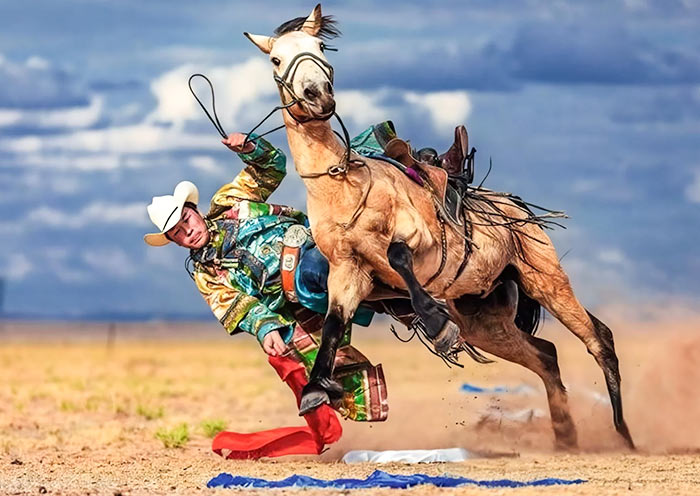
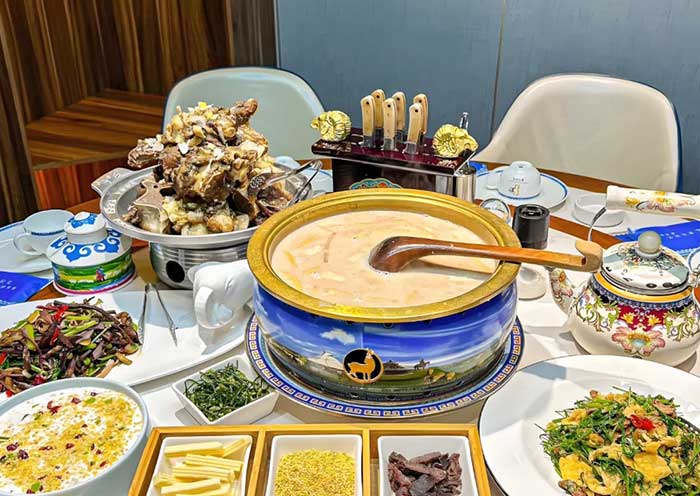
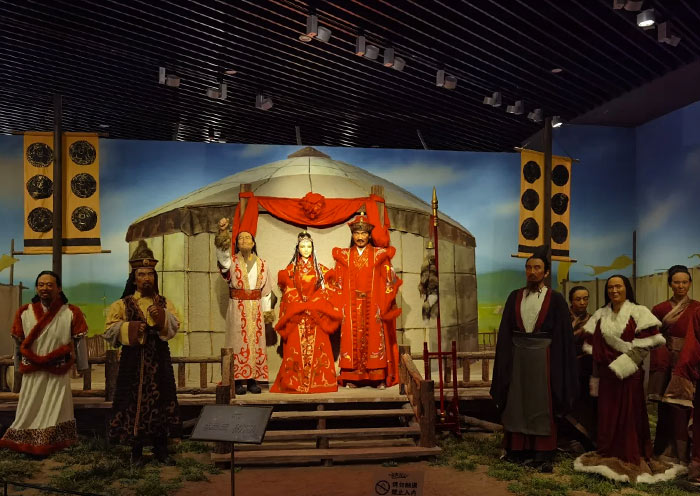
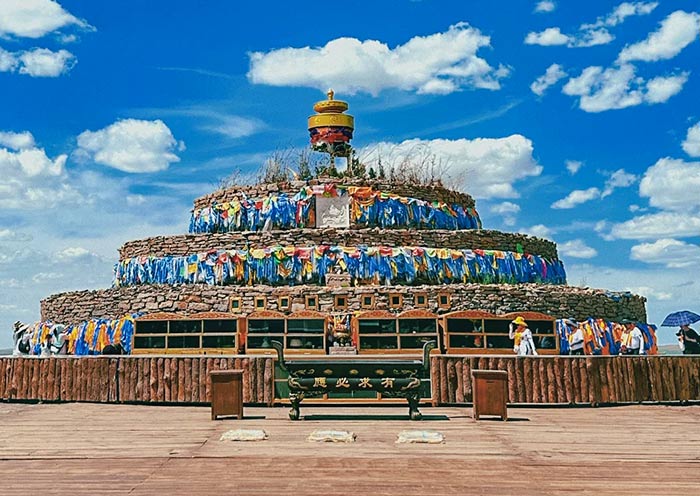
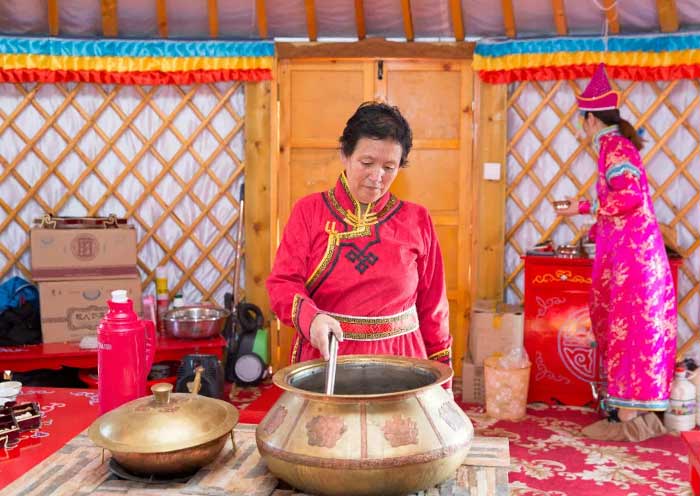
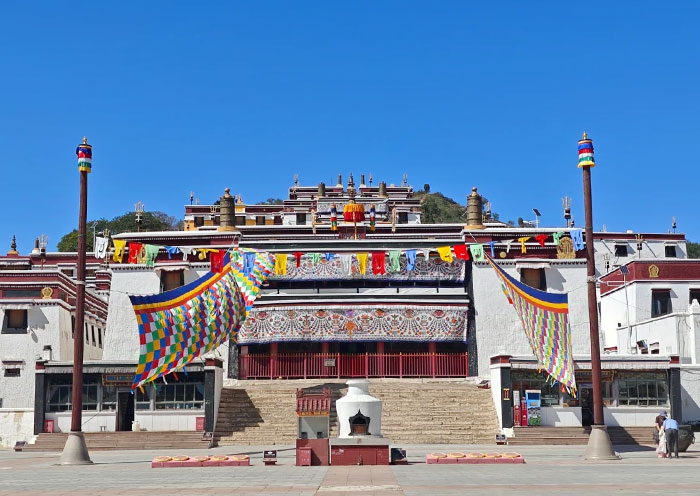
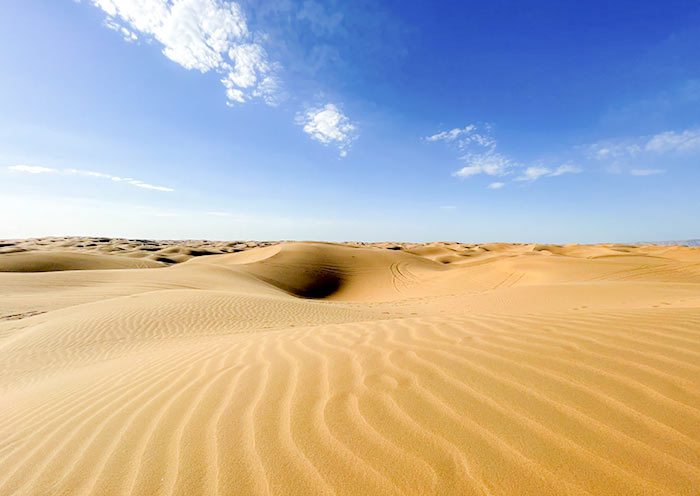
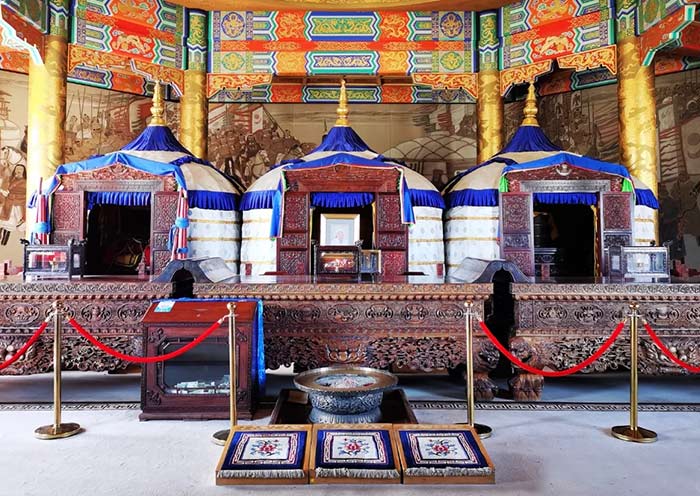
Itinerary at a Glance
Hohhot, Capital of Inner Mongolia (2 Days)
Inner Mongolia Museum (or Inner Mongolia Natural Museum; Closed on Mondays), Zhaojun Museum (Zhaojun Tomb; Closed on Tuesdays), Dazhao Temple (Silver Buddha Temple)
Baotou, Deer City (2 Days)
Xilamuren Grassland Naadam Festival, Xilamuren’s Hongge'er Aobao (Outdoor Live Show), Grassland Activities (Optional), Mongolian Yurt Stay (Bonfire Party), Xilamuren Grassland Sunrise (Optional), Wudangzhao Monastery (Potala Palace on the Grassland)
Ordos, Warm City (2 Days)
Kubuqi's Yemingsha, Desert Activties, Kubuqi Desert Sunrise (Optional), Mausoleum of Genghis Khan, Kangbashi District (Optional)
Itinerary Day by Day
Welcome to Hohhot, the capital of Inner Mongolia! Upon your arrival at the airport or train station in Hohhot, your driver will meet you at the exit and escort you to a carefully selected hotel in Hohhot City. The rest of the day is yours. Enjoy your Free Time in Hohhot City.
Located in the central part of Inner Mongolia Autonomous Region, Hohhot serves as the gateway to stunning grasslands and deserts, including Xilamuren Grassland, Huitengxile Grassland, and the famous Kubuqi Desert. Hohhot offers the best opportunities to experience grassland scenery & activities, explore nomadic life & festivals, and delve into Mongolian culture & history.
The name "Hohhot呼和浩特" means "Green City青城" in Mongolian. Legend has it that in 1581, Genghis Khan's descendant Alatan Khan (阿拉坦汗)settled here, constructing the city walls with blue-green stones from Daqing Mountain大青山, giving rise to the city's name. Hohhot is also known as "Zhao City" due to its numerous temples (Zhao meaning temples in Mongolian). Today, Hohhot is renowned as the Dairy Capital of China (中国乳都) and is home to global dairy giants Yili and Mengniu (伊利&蒙牛), both headquartered in the city.
Hohhot is a historic city dating back to the Warring States period (476 BC-221 BC). Shaped by ongoing cultural exchanges between the Central Plains and Grassland Ethnic Groups, Hohot boasts a wealth of historical and cultural attractions, including Dazhao Temple (Tibetan Buddhism), Zhaojun Tomb (commemorating one of ancient China's Four Beauties, who married a Xiongnu Chanyu), and the Inner Mongolia Museum, which houses treasures like the Xiongnu’s Eagle-Crested Golden Crown Ornament.
Free Time Ideas:
1.Inner Mongolia Museum of General’s Government Office (将军衙署博物院; Closed on Mondays): Visit the residence of frontier generals in the Qing Dynasty, uncover why it is acclaimed as "A General's Mansion, the history of the Green City一座将军府, 半部青城史."
2.Residence of Gurun Princess Kejing (清-固伦恪靖公主府博物院; Closed on Mondays): Explore the residence of Princess Heshuo和硕公主, the sixth daughter of Emperor Kangxi康熙皇帝. It is the most well-preserved Qing Dynasty princess mansion in China.
3.Kuan Alley Food Street (宽巷子民族美食街; Muslim Quarter): Stroll at Kuanxiangzi Street of Hui District for all kind of Mongolian food & halal food, such as Lamb Haslet Soup, Shaomai, Mongolian Milk Tea, or grilled lamb kebabs. You can also pay a visit to the Hohhot Mosque (Great Mosque) nearby.
Good to Know:
1.Inner Mongolia, China's third-largest province after Xinjiang and Tibet, stretches over 2,400 km from east to west, making it the country's widest region. Bordering Russia at Manzhouli and Mongolia at Erenhot, Inner Mongolia is inhabited by 24 million people. It's an ideal Summer Destination to immerse yourself in the Mongolian culture in the Yuan Dynasty and uncover the captivating life and heritage of Genghis Khan.
2.Inner Mongolia sits at an average elevation of 1,000-1,500 meters, with strong UV rays. Pack sunglasses, a hat & sunscreen. Temperatures can fluctuate between morning & evening, so pack warm coats, long pants & sports shoes. Mongolian food tends to be salty, oily & mildly spiced. Beef, mutton & noodles are staple dishes to try.
3.If your trip to Inner Mongolia happens to coincide with the Naadam Festival (内蒙古那达慕; usually in July or August), you'll have the exciting opportunity to witness the famous Three Games of Mongolia Men (男儿三艺): horse racing, wrestling, and archery. Each grassland/city has its own time of Naadam Fair (usually lasts for 3-7 days). Feel free to contact us if you want to join this major event in Inner Mongolia.
Arrival Ideas:
1.How to get to Hohhot By Air: Hohhot Baita International Airport (呼和浩特白塔国际机场) is about 24 km away from Dazhao Temple (Note: Hohhot Shengle International Airport 呼和浩特盛乐国际机场 will soon replace it by the end of 2025; 31 km from Hohhot Train Station). Direct flights connect Hohhot with major cities in China, such as Beijing (1h 20 min), Shanghai (2h 50 min), Chengdu (2.5h), Guangzhou (3h 20min), etc. It's essential to check flight schedules in advance, as not all routes operate year-round.
2.How to get to Hohhot By High Speed Train: Hohhot can be reached by train through Hohhot East Railway Station & Hohhot Railway Station. There are high-speed trains to Hohhot from Beijing (2h 50 min), Datong (1h 28 min), Taiyuan (3h 40 min), Shanghai (12h 11min), Xian (6h 35 min), etc. Contact us for ticket booking.
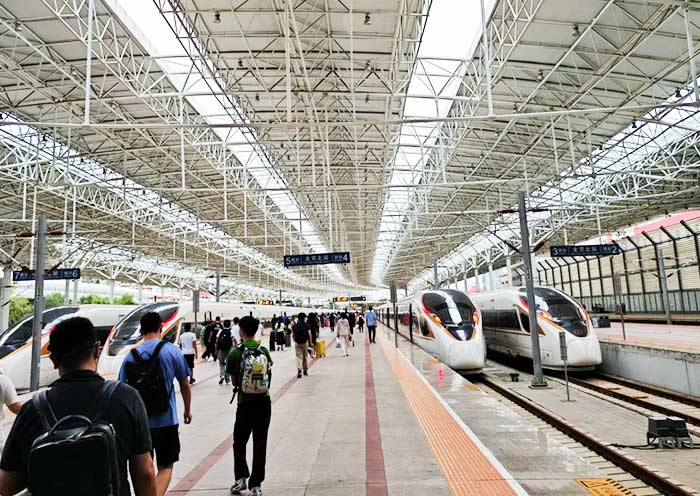
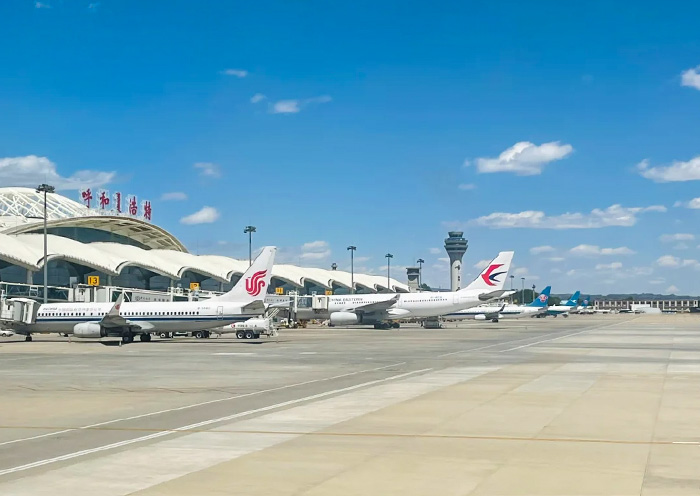
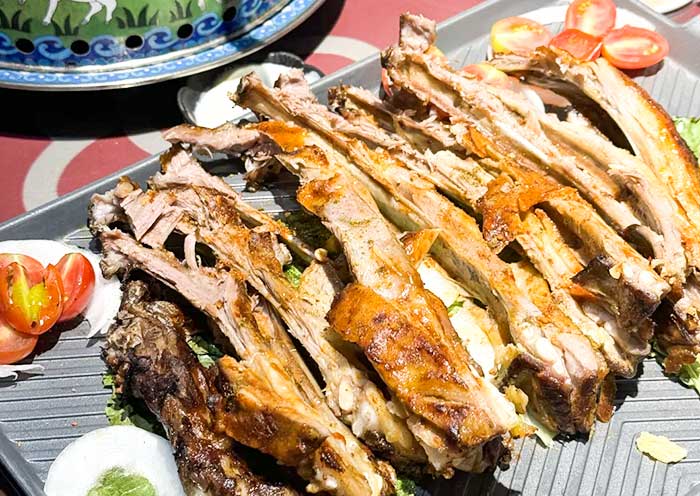
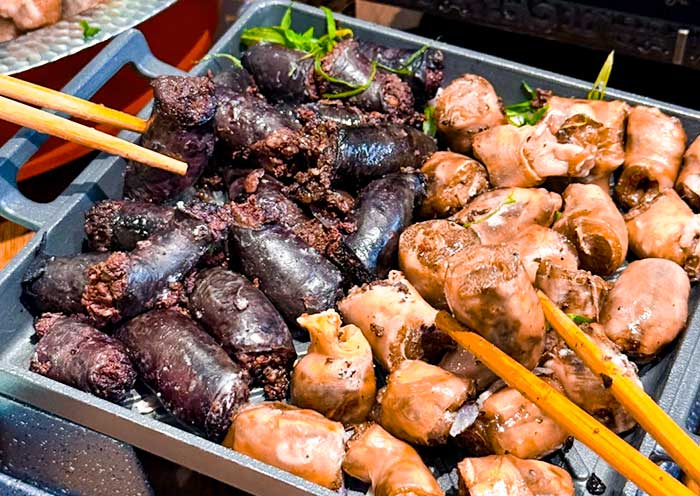
You can visit Inner Mongolia Museum, Zhaojun Museum (Zhaojun Tomb), and Dazhao Temple today. [Note: The Inner Mongolia Museum is currently closed due to moving to new buildings (updated on 23rd April, 2025), it may reopen soon. So we will arrange the trip to the Inner Mongolia Natural Museum instead.]
You can visit Inner Mongolia Museum (Closed on Mondays) for Grassland Culture. Founded in 1957, it is a national first-class museum with more than 150,000 collections, characterized by its fossils of ancient organisms (dinosaur fossils) and cultural relics of ancient Silk Road & northern ethnic groups (Mongolian, Khitan, Xiongnu). Inner Mongolia Museum is an "encyclopedia" to unveil the ecological change, culture, and historical development of the alpine grassland, deserts, forests, etc. You can trace the historical process of Inner Mongolia from prehistoric times, the Bronze Age, the Warring States to the Wei and Jin, the Liao and Jin, the Mongolian-Yuan to the Ming and Qing Dynasties, as well as modern times.
Take your time to find the Treasures of Inner Mongolia Museum, such as Golden Crown of the Xiongnu King (1,934 grams eagle crown of Warring States Period; 475–221 BC; 战国鹰形金冠饰), Painted Wooden Coffin (Liao Dynasty; over 1,000-year-old; 彩绘棺具), Incense Burner from Jun Kiln (小宋自造均瑶香炉; Yuan Dynasty), Nurosaurus Fossile (the biggest dinosaur in the Cretaceous Period in Asia), Northern Wei: Deer Head Gold Step Shaking Crown (北魏鹿首金步摇冠), Liao Dynasty Golden Mask (辽代黄金面具)…
Then, you can visit Zhaojun Museum. It is about 14 km from Dazhao Temple, where you can visit Zhaojun Tomb, Museum of Hun Culture, Chanyu Big Tent (Dance Show about Zhanjun’s Wedding), Heqin Palace (Culture about Making Peace through Marriage), Zhaojun Room, and Painting & Calligraphy Room (Art Works about Zhaojun).
The Zhaojun Museum, where you can learn about the renowned historical figure Wang Zhaojun from the Western Han Dynasty (206 BC - 24 AD). Wang Zhaojun was among the four most beautiful women in ancient China. Legend has it that these four ladies were so stunning that they could "make fish sink, wild geese descend, shame the moon, and make flowers blush沉鱼/落雁/闭月/羞花". The phrase "wild geese descend落雁" comes from the tale of Zhaojun Chu Sai (昭君出塞). In 33 BC, during a meeting between the Xiongnu Emperor, Hu Han Ye Chanyu (呼韩邪单于), and the Western Han Emperor, Liushi (汉元帝刘奭), Chanyu expressed his willingness to marry a Han woman to establish peace. Wang Zhaojun, a concubine of Emperor Liushi, volunteered to marry Chanyu to promote harmony between their people. Saying goodbye to her rich homeland, she ventured beyond the Great Wall to the Chanyu's impoverished grassland dwelling.
During her travels, amidst the rolling yellow sands and the sounds of galloping horses and wild geese, Wang Zhaojun felt unsettled. To soothe her emotions, she played a sorrowful tune on her instrument. Her poignant music, combined with her beauty, mesmerized the migrating wild geese, causing them to stop mid-flight and fall to the ground. This captivating moment led to the poetic nickname "wild geese descend" for Wang Zhaojun. Her selfless act paved the way for over 60 years of peace between the Han and Xiongnu. This historical event is passed down from generation to generation and is widely known as Zhaojun Chu Sai. Wang Zhaojun is now revered for her grace, intelligence, and diplomacy, with her story immortalized in Chinese poetry, drama, and literature.
You will see the bronze statues of Wang Zhaojun and her husband near Zhaojun Tomb, depict a vivid picture of them riding horses and talking to each other intimately. It symbolizes not only their love, but also the friendship between the Han & the Xiongnu (a nomadic ethnic group living in North China). Standing at Zhaojun Tomb (Qingzhong青冢), the Resting Place of One of China’s Greatest Women in History, you may feel the breeze that blows here 2,000 years ago. You should not miss visiting the Museum of Hun Culture, the only museum about Xiongnu Culture (匈奴文化) with the Huns’ historical relics and art crafts about Zhaojun.
After that, time to head to explore Dazhao Temple (大召寺/大召无量寺). The Dazhao Temple, founded by Alatan Khan (阿拉坦汗/俺答汗; 1508-1582), the leader of the Mongolian Tumote tribe in the Ming Dynasty, was established in 1579. In the square in front of the Dazhao Temple, you will see the legendary builder of the temple, Alatan Khan (the reincarnations of Kublai Khan 忽必烈的转世). The temple is also known as the "Silver Buddha Temple" because it houses a statue of Sakyamuni made of 30,000 taels of pure silver (brought to light by the 3rd Dalai Lama, Sonam Gyatso, the reincarnations of Buton Rinchen Drub; 三世达赖喇嘛索南嘉措/八思巴的转世).
The Dazhao Temple is also known as the "Three Wonders" - the silver Buddha, dragon carvings, and mural, which are all historical relics from the Ming Dynasty. This temple is not only the earliest Tibetan Buddhist temple in Hohhot but also the largest Tibetan Buddhist holy site (Yellow Sect Gelug School) in Inner Mongolia. The temple is laid out in a north-south direction along the central axis, combining Han, Tibetan, and Mongolian architectural styles, attracting architecture enthusiasts and photographers for its Royal Architecture with Yellow glazed tiles (黄琉璃瓦), which can only be used in royal buildings.
In the Qing Dynasty, the Dazhao Temple was also the ancestral temple of Emperor Kangxi (康熙皇帝; 1654-1722). To this day, the tablets of Emperor Kangxi and his father, Shunzhi (顺治皇帝), are still enshrined in the temple. Inside the main hall, you can see the over 400-year-old silver-cast Buddha statue (made by Nepalese craftsmen), a golden coiled dragon about 10 meters high before the silver Buddha, as well as precious cultural relics such as the dragon and phoenix peacock umbrella, the pearl octagonal palace lantern, the wealth deity statue gifted by Kangxi Emperor to Dazhao, and precious Tangkas from the Ming and Qing dynasties.
Don't miss the Sakyamuni Eight Pagodas (释迦八塔) at the Dazhao Temple, representing the eight virtues of the Buddha. Additionally, on the fifteenth day of the first lunar month and the fifteenth day of the sixth lunar month each year (Buddha Thangka Unveiling Ceremony; 晒佛节/恰木舞蹈), the Dazhao Temple hangs giant Tangkas from the temple's precious collection on the scripture drying poles. Try your luck to meet local evens in Dazhao Temple.
Free Time Ideas:
1.Visit More Temples in Hohhot: You can hike to more landmarks of Hohhot, such as Xilitu Zhao Temple (席力图召/小召寺; across the street from Dazhao Temple; Self-pay) & Five Pagodas Temple (五塔寺博物馆; about 1 km from Dazhao Temple; Closed on Mondays).
2.Explore Hohhot Food: You can take a stroll from Altan Khan Square (阿拉坦汗广场/大召广场; Dazhao Square for Altan Khan Statue) to Saishang Old Street (塞上老街) and Tongshun Alley (通顺大巷). These are popular streets (near Dazhao Temple) with Ming and Qing-style buildings for enjoying local food and shopping for local souvenirs.
3.Uncover Dashengkui Museum Cluster (大盛魁博物馆集群; 1.1 km from Dazhao Temple): It comprises the Dashengkui Cultural Museum (Closed on Mondays), Yongsheng Ceramic Museum, Morin Khuur Museum (Horse-head Fiddle Museum)... Established by Jin/Shanxi merchants (晋商), Dashengkui was China's first privately owned joint-stock enterprise along the Tea Road between China and Russia. Dashengkui, nicknamed "Half Guihua City 半个归化城", brought prosperity to Guihua City (Hohhot).
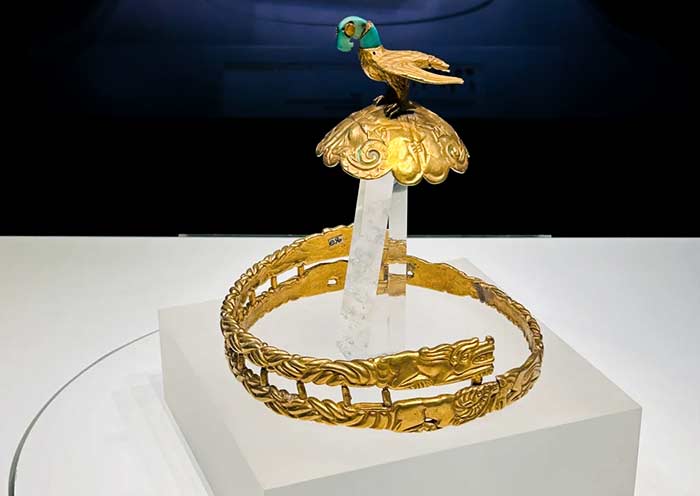
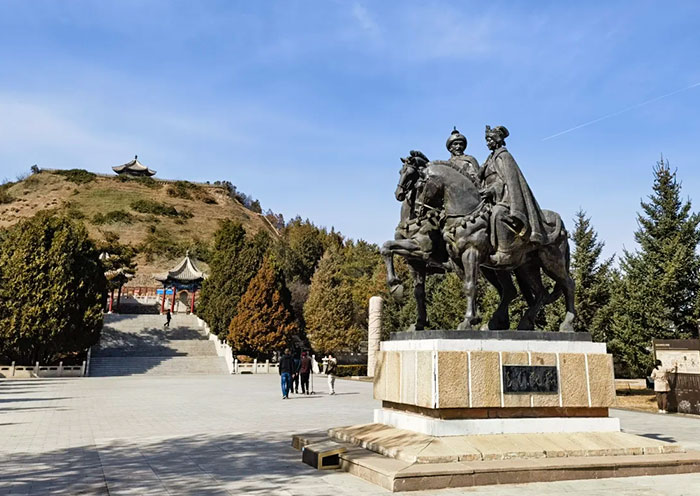
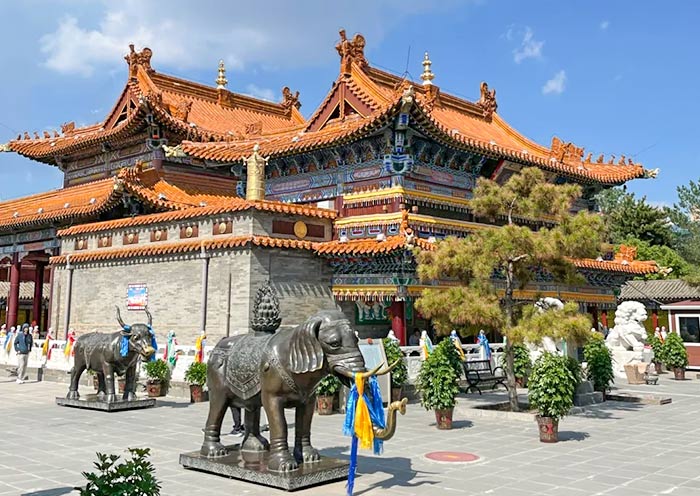
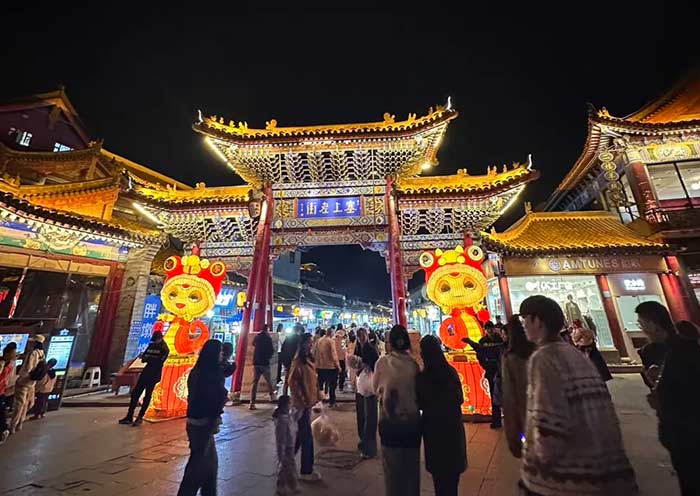
This morning, you will head to Xilamuren Grassland of Baotou for Naadam Festival. It is about a 2-hour drive (83 km). You can visit Hongge'er Aobao for outdoor live show (Optional). Then, you will stay overnight at a Mongolian Traditional Yurt with a Bonfire Party (Mongolian song & dance).
Xilamuren Grassland (希拉穆仁草原), the closest grassland to Hohhot, is one of the most beautiful and vast grasslands in Inner Mongolia. As the first grassland in Inner Mongolia to be developed into a tourism attraction & a popular summer destination in China, it offers the most nomadic experience in the grassland.
When you reach Xilamuren Grassland, you can experience the vibrant Naadam Opening Ceremony (do double-check the date), a grand celebration of Mongolian dance, music, and culture. Naadam means ‘games’ in the Mongolian language. The festival is often called “Eriin Gurvan Naadam,” which translates to “Three Manly Games.” It is a traditional festival with over 2,000 years of history, which was listed on the UNESCO List of the Intangible Cultural Heritage of Humanity.
The Naadam dates back to the era of Genghis Khan, who used these games to train his warriors and keep them fit for battle. Today, you can join this "Olympics of the grassland people" by witnessing thrilling competitions like horse racing, wrestling, archery, chess, and more. Traditionally, Naadam marks a time of harvest and gratitude for the nomadic communities. It’s a time for families to reunite, celebrate, and give thanks.
Now, Naadam is not only a showcase of strength, speed, and skill but also a time for grassland nomads and world-wild travelers to gather together to celebrate the short and joyful summer. Immerse yourself in grassland activities, try local cuisine like hand-stripped mutton and milk tea, and admire colorful traditional costumes.
Highlights of Three Manly Games:
1.Wrestling (Bokh): Mongolian wrestling has no weight classes. Wrestlers wear traditional uniforms and compete until one touches the ground. The victor earns the title of Champion of Naadam. In ancient times, heroes were often selected this way, and Mongolian nobles often chose sons-in-law in this way.
2.Horse Racing (Morin Khuur): Unlike Western-style horse racing, Naadam’s races are long-distance endurance events (10–30 km). The riders are often young children, showcasing incredible skill and bravery.
3.Archery (Kharvaa): Archers use traditional Mongolian bows and arrows, often made from wood and sinew. Men, women, and children participate, aiming at targets from distances of 60–75 meters.
Note:
Naadam in Inner Mongolia doesn't have fixed Gregorian dates. Summer Naadam typically falls in July or August, around the fourth day of the sixth lunar month, lasting about 3 to 7 days according to the region. Double-check the date with us.
Next, pay a visit to Hongge'er Aobao Scenic Area (红格尔敖包), the largest Aobao in Xilamuren Grassland. It has a history of over 400 years. Join the locals in performing the "kora," a ritual walk around the Aobao, a sacred site where Mongolians worship, offer sacrifices, pray, and make wishes. Enjoy a panoramic view of the grassland from the Aobao before witnessing the Large-scale Live Equestrian Drama (草原大型实景马术剧; Optional), a spectacular outdoor show showcasing Mongolian culture, including the renowned Three Games of Men (男儿三艺) - Horse Racing, Wrestling, and Archery.
Optional Grassland Activities: (Self-pay)
1.Horse Riding on Huitengxile Grassland if the weather permits.
2.Mongolian Family Visit for Nomadic Life Experience.
3.Join local “Three Manly Games”: Horse Racing, Wrestling, and Archery.
Note for Horseback Riding on Inner Mongolia Grasslands:
1.Guided Ride (Beginners): Most common and safest for first-timers. A herdsman leads your horse for a walk within a designated area.
2.Independent Ride (Experienced Riders): If you're skilled, you might rent a horse from a local herder for free riding. However, this comes with no safety guidance and isn't generally recommended.
3.The fee for Guided Ride and Independent Ride are different. Do double check the price and riding time before enjoy your horse riding.
Cap off the day by participating in a lively Bonfire Party featuring Mongolian singing and dancing after dinner. Experience the enchanting starlit sky over the grassland as you spend the night in a traditional Mongolian yurt.
Dinner Optional: (Self-pay)Mongolian Traditional Zhama Banquet Dinner (诈马宴): Try roasted whole sheep (烤全羊) and other famous Mongolian dishes while dressed in traditional Mongolian attire, enjoying Mongolian ethnic song and dance, and experiencing Mongolian silver bowl and hada ceremonial toasting rituals...
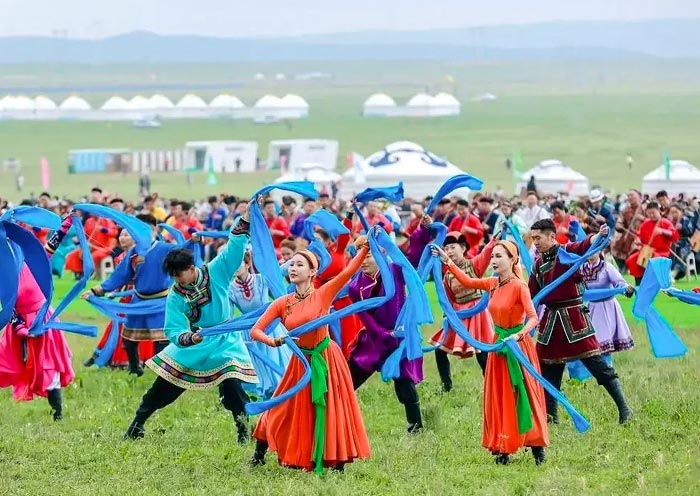
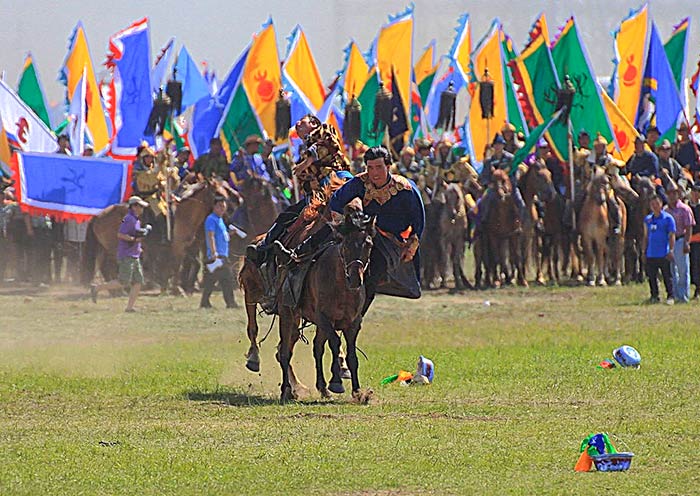
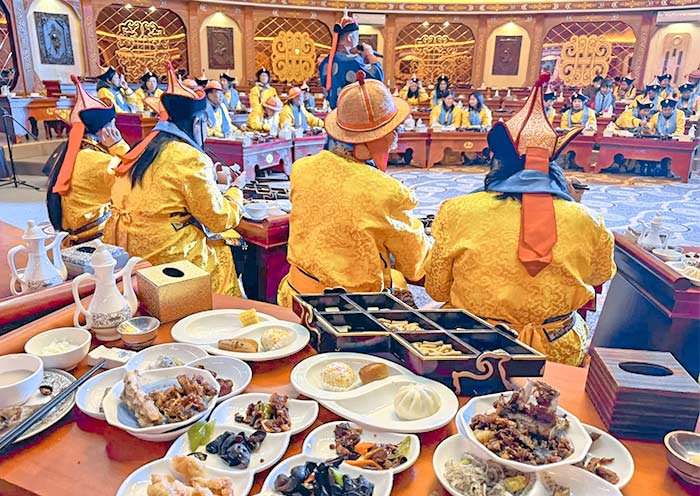
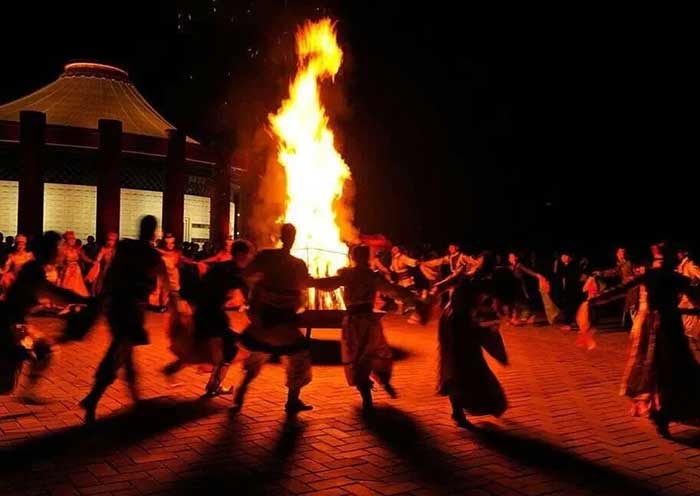
This morning, you can choose to get up early (around 4:00 am) to wait for an amazing sunrise at Xilamuren Grassland (Optional). Then, head to Wudangzhao Monastery of Baotou (180 km, 3h), which was once the residence of the most powerful Lama in Inner Mongolia. At last, head to Yemingsha of Kubuqi Desert for overnight (185 km, 3h).
Wudangzhao Monastery (Wudangzhao Temple) is one of China's Four Great Tibetan Buddhist Monasteries of the Gelugpa sect (Yellow Hat), alongside the Potala Palace in Tibet, Labrang Monastery in Gansu, and Kumbum Monastery in Qinghai. Known as the "Potala Palace on the Grassland," it is the largest Tibetan Buddhist monastery in Inner Mongolia. Founded during the Kangxi reign of the Qing Dynasty (1662–1722) by the first Living Buddha, Lobsang Jigme Gyatso, it was modeled after Tibet’s Tashilhunpo Monastery and expanded over centuries into its current scale.
You will see the monastery's classic Tibetan Buddhist architecture, with no central axis. Its grand halls are irregularly scattered across a 1.5-kilometer-long south-facing slope in a valley. The complex includes six main prayer halls (originally eight), three Living Buddha residences, and a reliquary hall housing stupas of past lamas. Spanning over 300 acres, it contains more than 2,500 rooms. You will marvel at the intricate murals, thangka paintings, and Buddha statues inside the halls, as well as prayer wheels, white stupas, and mani stone mounds along the paths. A deer park allows close encounters with friendly deer.
For panoramic views of Wudangzhao Monastery, hike the southern hill (if time permits). During the annual temple fair (25th day of the 7th lunar month to 1st day of the 8th lunar month), monks perform rituals such as Thangka Unveiling, scripture chanting, and sacred Cham dances. Welcome to this Buddhist sanctuary in the heart of the grasslands - a spiritual journey awaits.
At last, head to Kubuqi's Yemingsha. (You can choose to overnight at a Camp or a hotel in the desert. Let us know in advance). As dusk falls, capture a breathtaking desert sunset before indulging in a delicious barbecue dinner. Finally, drift to sleep under a canopy of brilliant stars in the tranquil desert night.
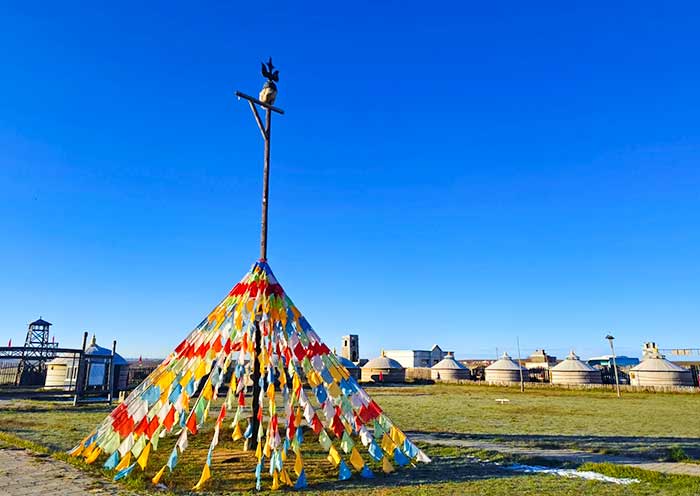
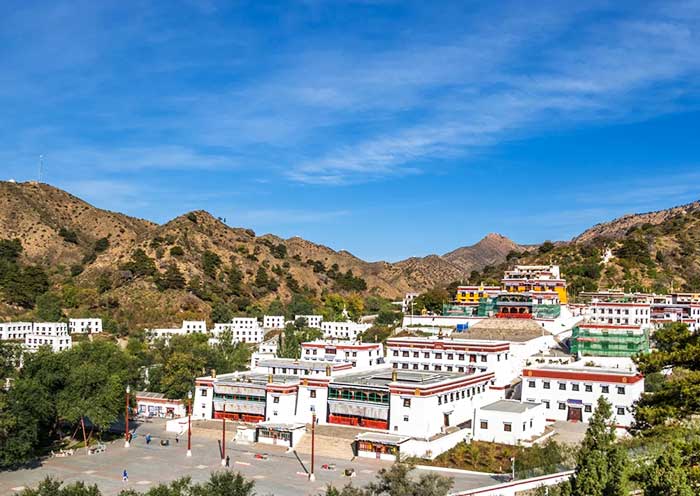
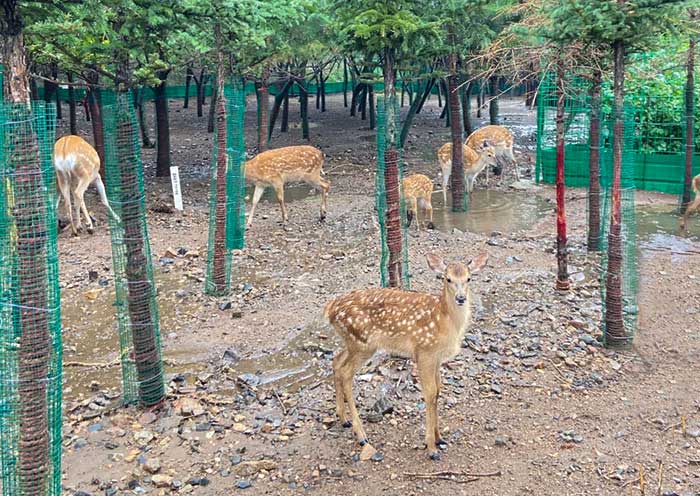
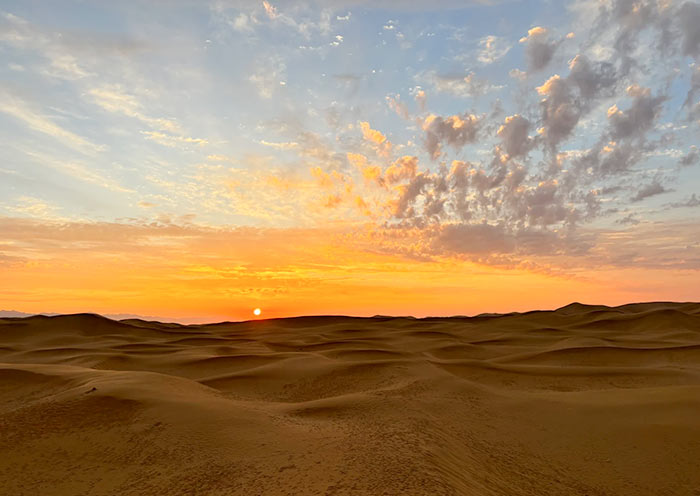
Today, you can get up early (around 4:00 am) to wait for an amazing sunrise at Kubuqi Desert (Optional). Enjoy all kinds of desert activities in Kubuqi’s Yemingsha before heading to visit Mausoleum of Genghis Khan (220 km 3.5h) in the afternoon.
Kubuqi Desert (库布其沙漠) is the seventh-largest desert in China. It was once renowned as the “Sea of Death”. Now, with tree planting projects & the development of solar energy over the generations, the vegetation coverage has been significantly improved. It is promising to witness the Sea of Death become the Sea of Green. Now, the Kubuqi Desert is one of the top desert destinations in China.
Yemingsha (夜鸣沙) is located at the Hinderland of Kubuqi Desert. Experience the magic of Kubuqi's Yemingsha Desert with an unforgettable adventure. Enjoy thrilling desert activities like camel rides, sand sliding, and ATV excursions. (Note: Do double check with us for the ticket/fees with desert activities in Yemingsha).
Desert Travel Tips:
1.Sunscreen, sand protection, and hydration: It is advisable to bring sunscreen, sunglasses, hats, and protective clothing. High-top shoes are essential for sand protection. Protect your phone and camera from sand. The desert is dry, so carry more than 2 liters of water per person.
2.Desert Dress code: Wear light, long-sleeved clothing for UV protection in summer and down jackets in winter (there is a significant temperature difference between day and night).
3.Safety and environmental protection tips: Do not venture alone into uninhabited areas, follow project safety regulations, and be cautious on steep dunes. Do not litter; protect the desert ecosystem.
4.Photography tips: The best lighting for capturing dunes is one hour after sunrise and one hour before sunset, when the light and shadows create the most striking contrasts.
After the adventure in Yemingsha, time to head to Mausoleum of Genghis Khan, a sacred shrine of the founder of the Mongol Empire - Genghis Khan (1162- 1227).
As Mongolia’s Greatest Leader, Genghis Khan consolidated tribes into a unified Mongolia, extended his empire across Central Asia and other countries as far west as Eastern Europe (from the Pacific Ocean to the Mediterranean Sea). Genghis Khan, the most famous warrior in the history of the world, built the biggest empire in history up to that time. He left a vast empire for his descendants, laying the foundation for the Yuan Dynasty (1279-1368) and the reunification of China.
Today, Genghis Khan is still worshiped by those who are interested in Mongolian history, culture, and traditions. Due to the Mongolian custom of "secret burial," the exact location of Genghis Khan's actual tomb remains a mystery. The mausoleum currently houses the camel hair that absorbed Genghis Khan's last breath (灵魂的驼毛), symbolizing his soul, which has been cherished for centuries.
Since 1227 (the death of Genghis Khan), the Da'erhute tribe (达尔扈特人), the ancestors of whom were the guard troops of Genghis Khan, has taken good care of this mausoleum for more than 700 years. If you happen to visit here during its Spring Ceremony (成吉思汗春祭大典), you will witness Mongolian shamanistic rituals and ceremonies that are organized and held by the Da'erhute tribe, offering a deep spiritual connection to the legacy of Genghis Khan. You will see that this mausoleum is a sacred place for Mongolian people to honor and celebrate their national hero.
The mausoleum complex, built in a traditional Mongolian architectural style, is composed of two parts: the Tomb Complex and Donglian Scenic Area. It covers an area of around 13.6 acres with more than 2,500 halls, sutras, and monks’ houses. It houses a vast collection of relics and artworks about the life of the legendary Mongolian Emperor and the history of the Mongol Empire. Don’t miss the chance to see the sabers, swords, arrows, bows, and other weapons that were used by Genghis Khan.
Highlights of the Mausoleum of Genghis Khan:
1.Spirit Hall: Houses a golden statue of Genghis Khan and symbolic relics.
2.Main Hall: Features murals and exhibits on the Mongol Empire’s history.
3.Eternal Flame: A sacred flame symbolizing the undying spirit of Genghis Khan.
4.Cultural Performances (Optional; Self-pay): Experience traditional Mongolian dances, music, and ceremonies.
5.Mongolian Rituals: Participate in or observe spiritual rituals performed by Dalhut Mongols (if your visit time meets their ceremony dates).
Note:
Spring Ceremony/Ritual at the Mausoleum of Genghis Khan成吉思汗春祭大典:
Called Tsagaansurek, or "milk sacrifice" in Mongolian, the spring ritual uses the milk of white horses as a sacrifice to peace and prosperity. Every year, ethnic Mongolians hold four rituals, one in each season, to Genghis Khan. The spring ritual is the grandest at the shrine and lasts for eight days. Genghis Khan memorial rituals were inscribed as China's intangible cultural heritage in 2006. (Contact us to double check the dates of the Ceremony/Ritual.)
After that, overnint in Ordos. Located on the Ordos Plateau, within the bend of the Yellow River, Ordos is a city of happiness that warms the world. Prairies, deserts, or valleys, all their multiple landscapes are poetic. Ordos is one of the richest city in China (2024 GDP even surpass Beijing/Shanghai/Guangzhou), thanks to stores of coal, gas, and rare earth metals. Its cashmere output accounts for 13% of the world's total, and the unique Albas white goat cashmere is of prime quality in the world; that is why Ordos is called Warm City.
Free Time Ideas:
1.Kangbashi District: The Richest ‘Ghost Town’ in China
IN 2010, Time Magazine sardonically reported that Kangbashi, in Ordos, Inner Mongolia, is ‘a new Chinese city that, apart from people, has everything’. Now, Kangbashi has become a top tourist area with lots of museums, squares (including Genghis Khan Square), theme parks, a lake, and modern facilities (no-driver bus/taxi).
2.Ordos Musical Fountain of Kangbashi (Asia's Tallest Fountain)
This Fountain is located in the Kangbashi District at the Wulanmulun Riverside Square (adjacent to the Wulanmulun Lake). It combines sound, light, water, and color elements into one. The main fountain can reach a height of 230 meters, earning it the title of "Asia's Tallest Fountain." The fountain performances are held every evening from 8:00 PM to 9:00 PM (may be temporarily suspended in adverse weather conditions).
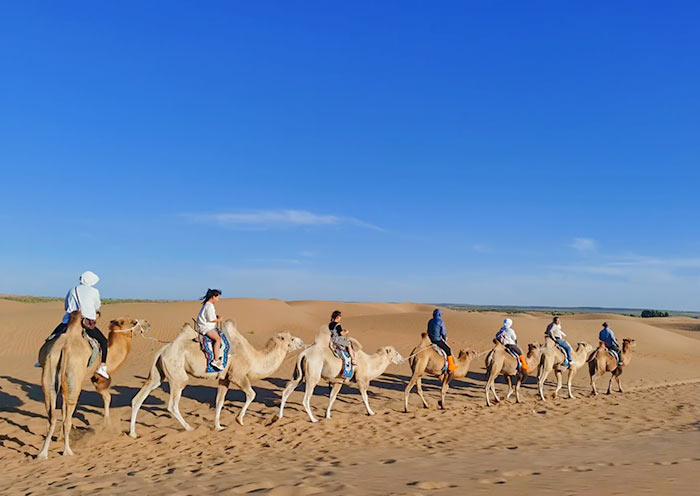
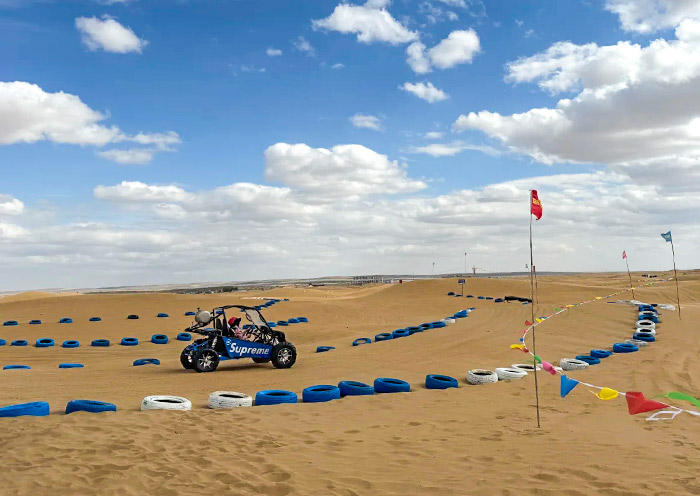
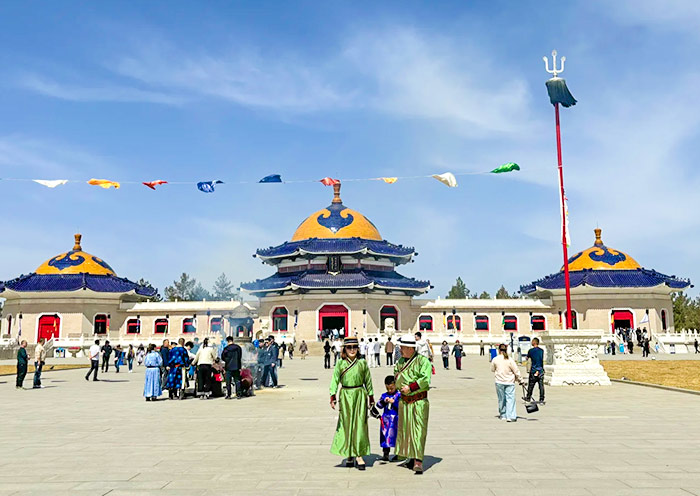
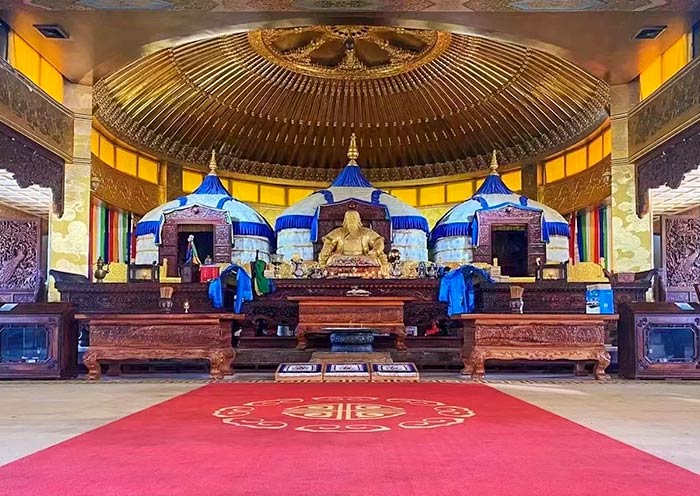
Today you can depart from Ordos by train or flights. Or you can head back to Hohhot (280 km, 3.5h) for departure.
At last, it is time to end your 6 Days Inner Mongolia Naadam Tour. Thank you for choosing Asia Odyssey Travel (AOT) for your China Tour, and we are always here working for you and hope to see you again for your next trip to Asia. Safe journey!
Extension Ideas:
1.You can extend your Hohhot Tour to other cities in Inner Mongolia, such as Baotou, Ordos, Ejin Banner, Badain Jaran Desert, and Hulunbuir. Please feel free to let us know, we can help you with the arrangements.
2.You can extend your Inner Mongolia Tour to other cities in China, such as Beijing, Shanxi (Datong/Pingyao/Wutaishan/Taiyuan), Gansu (Zhangye/Lanzhou/Dunhuang/Jiayuguan), Ningxia, Xian, Luoyang, Chengdu (Sichuan), and Shanghai, etc. We can customize your itinerary.
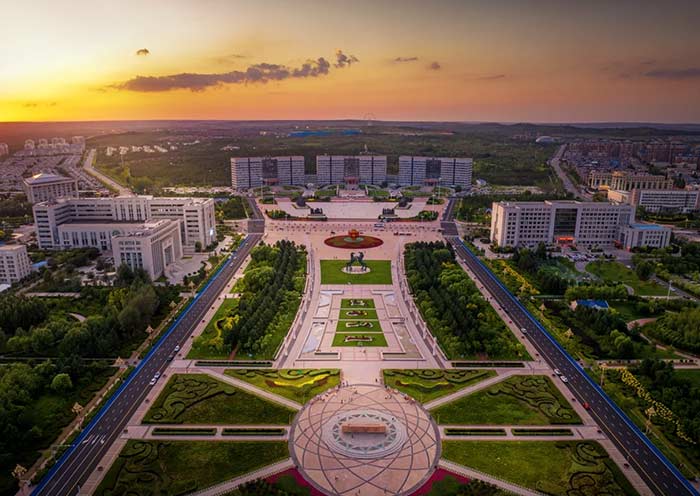
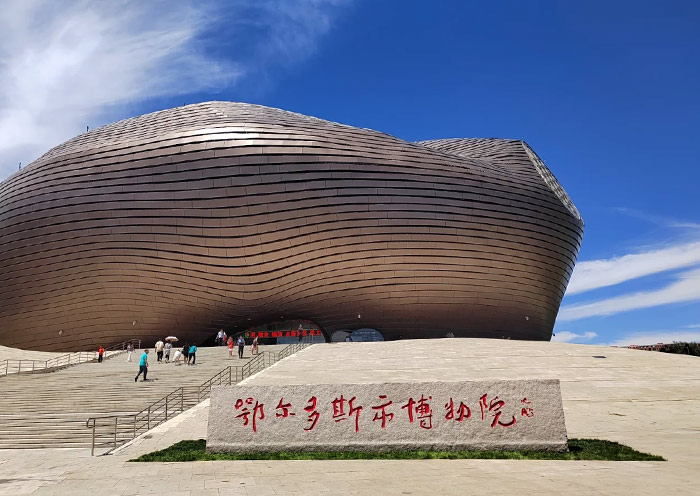
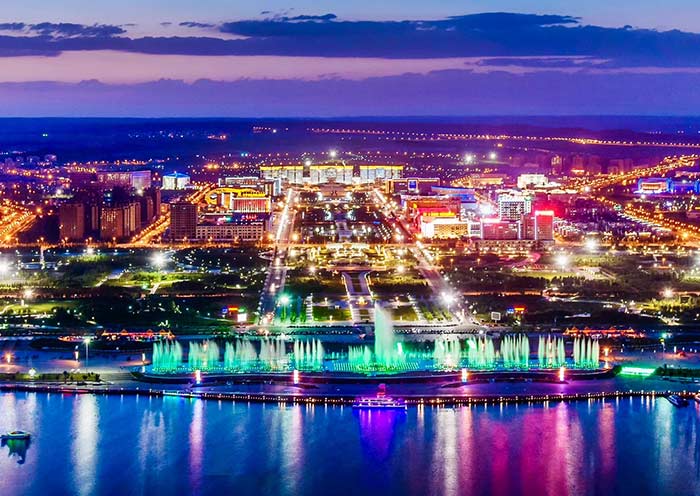
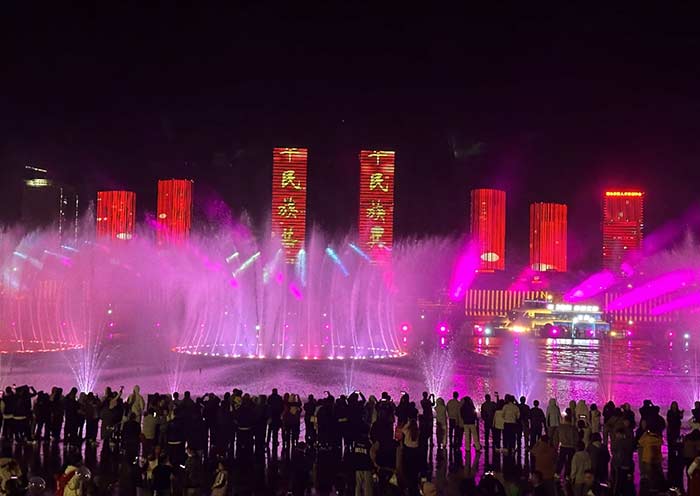
Price: What’s Included & What’s Excluded
What’s Included?
What’s Excluded?
Important Trip Notes for Booking a Inner Mongolia Tour
Accommodation & Hotel Condition for Your Inner Mongolia Tour
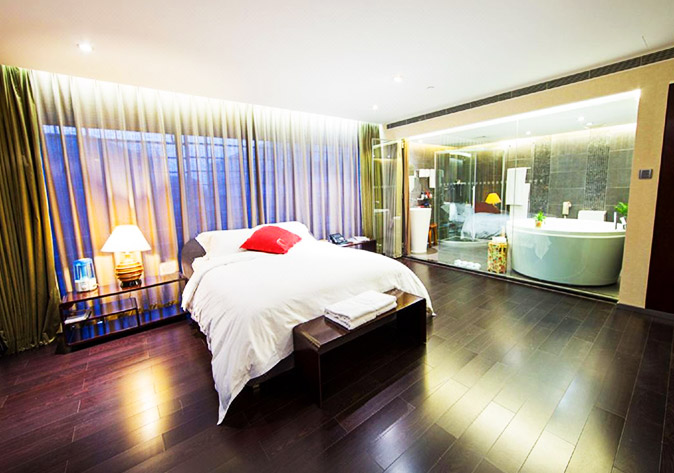

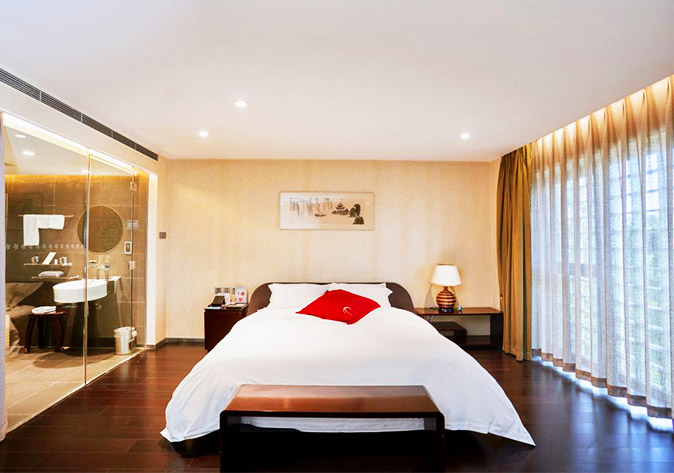
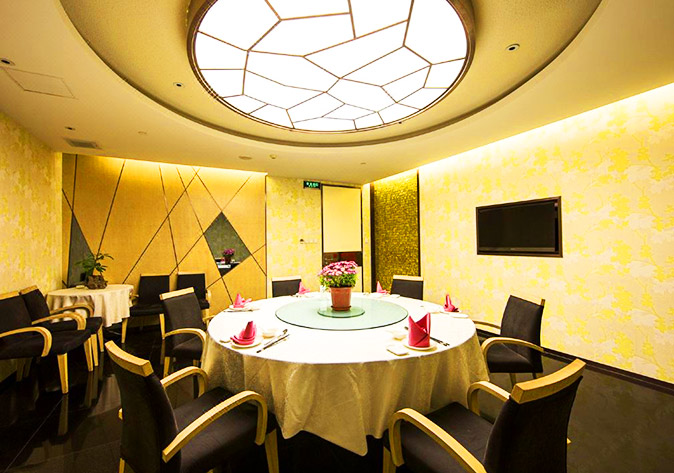
Have a good sleep everyday is very important during your Inner Mongolia tour. In a private tour, you can decide on your own which hotel class you want - luxury 5 star, comfortable 4-star, Mongolia yurt or economic 3-star.
All the hotels in each destination we selected are at good location, close to commercial street or tourist attractions. And, all the hotels we use have a business relationship for many years and they have windows, air-conditioners, hot water, showers... (except for basic accommodation condition when overnight in yurt or camping) to ensure you luxury and comfortable sleep experience. The staff (from big city) can speak English and they will provide you the high quality service. If you have any requirements, you can ask them (or your guide) to help.
Photo Gallery for This Itinerary
Latest Inner Mongolia Tours Reviews from Our Customers

Emily
UK
Destination(s): InnerMongolia
Date of Experience: Jul 19, 2025
Tour Customized by: Rita
You May be Interested in This Tour: 6 Days Naadam Festival Tour 2025: Attend the Grandest Festival in Inner Mongolia

Tatiana
Russian
Owen from Asia Odyssey Travel is always online with our questions. Our guide, May, was a cultural treasure—fluent in English, she shared fascinating local lore and ensured every moment felt authentic. Our driver, Ben, navigated grasslands and border roads with skill, keeping us safe and comfortable. Highly recommend!
Destination(s): InnerMongolia
Date of Experience: Jul 02, 2025
Tour Customized by: Owen
You May be Interested in This Tour: 6 Days Best Hulunbuir Tour: Grassland, Wetland, Lake & Border Culture

Jin-soo
South Korean
Our Inner Mongolia tour from Beijing was incredible! We absolutely loved the Huitengxile Grassland – so vast and beautiful. The Kubuqi Desert offered thrilling adventures like camel riding. Experiencing both landscapes in one trip was truly unforgettable. Highly recommend!
Destination(s): InnerMongolia
Date of Experience: Jul 22, 2024
Tour Customized by: Daria
You May be Interested in This Tour: 5 Days Inner Mongolia Tour from Beijing - Escape to Huitengxile Grassland
Price: Request
(Based on a private tour for two people. Price varies depending on program, travel date, number of people.)
Free Enquiry! You don’t need to pay for the reservation.
- United States (+1)
- Australia (+61)
- Singapore (+65)
- Malaysia (+60)
- Philippines (+63)
- Canada (+1)
- Italy (+39)
- Indonesia (+62)
- United Kingdom (+44)
- Spain (+34)
- Mexico (+52)
- Hong Kong (+852)
- Thailand (+66)
- United Arab Emirates (+971)
- New Zealand (+64)
- South Africa (+27)
- Germany (+49)
- Brazil (+55)
- India (+91)
- France (+33)
- Vietnam (+84)
- The Netherlands (+31)
- Saudi Arabia (+966)
- Ireland (+353)
- Argentina (+54)
- Switzerland (+41)
- Romania (+40)
- Pakistan (+92)
- Japan (+81)
- Portugal (+351)
- Bangladesh (+880)
- South Korea (+82)
- Puerto Rico (+1)
- Türkiye (+90)
- China (+86)
- Belgium (+32)
- Qatar (+974)
- Greece (+30)
- Taiwan (+886)
- Austria (+43)
- Poland (+48)
- Israel (+972)
- Chile (+56)
- Sri Lanka (+94)
- Nigeria (+234)
- Peru (+51)
- Colombia (+57)
- Hungary (+36)
- Nepal (+977)
- Denmark (+45)
- Bulgaria (+359)
- Norway (+47)
- Slovenia (+383)
- Sweden (+46)
- Kuwait (+965)
- Costa Rica (+506)
- Ecuador (+593)
- Venezuela (+58)
- Malta (+356)
- Croatia (+385)
- Tunisia (+216)
- Czechia (+420)
- Mongolia (+976)
- Bahrain (+973)
- Mauritius (+230)
- Papua New Guinea (+675)
- Cambodia (+855)
- Dominican Republic (+1)
- Luxembourg (+352)
- Finland (+358)
- Guatemala (+502)
- Myanmar (+95)
- Maldives (+960)
- Slovakia (+421)
- Laos (+856)
- Serbia (+381)
- Brunei (+673)
- Oman (+968)
- Macao (+853)
- Panama (+507)
- Morocco (+212)
- Jordan (+962)
- Georgia (+995)
- Fiji (+679)
- Bolivia (+591)
- Lithuania (+370)
- Bahamas (+1)
- Cyprus (+357)
- Latvia (+371)
- Bhutan (+975)
- Iraq (+964)
- Iran (+98)
- Kenya (+254)
- Jamaica (+1)
- Zimbabwe (+263)
- Azerbaijan (+994)
- Uruguay (+598)
- Estonia (+372)
- Andorra (+376)
- Cameroon (+237)
- Ghana (+233)
- Kazakhstan (+7)
- Nicaragua (+505)
- Egypt (+20)
- Russia (+7)
- Albania (+355)
- Réunion (+262)
- Montenegro (+382)
- Algeria (+213)
- Afghanistan (+93)
- Martinique (+596)
- Uganda (+256)
- Honduras (+504)
- North Macedonia (+389)
- Trinidad and Tobago (+1)
- Suriname (+597)
- Antigua and Barbuda (+1)
- Zambia (+260)
- Ukraine (+380)
- Armenia (+374)
- Barbados (+1)
- Belarus (+375)
- Palestine (+970)
- Lesotho (+266)
- Moldova (+373)
- Ethiopia (+251)
- French Polynesia (+689)
- Gambia (+220)
- Guam (+1)
- Gibraltar (+350)
- Isle of Man (+44)
- New Caledonia (+687)
- El Salvador (+503)
- Comoros (+269)
- Seychelles (+248)
- Chad (+235)
- Samoa (+685)
- Cook Islands (+682)
- Palau (+680)
- Paraguay (+595)
- DR Congo (+243)
- Solomon Islands (+677)
